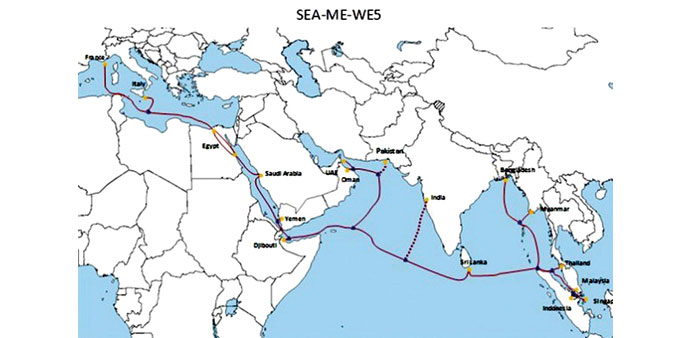While the new SEA-ME-WE 5 cable is expected to reduce the outages of data traffic in the region, Middle Eastern countries have decided not to rely entirely on undersea cables that run around their mainland
By Arno Maierbrugger
Gulf Times Correspondent/Hong Kong
|
|
Two huge Internet cable projects, one submarine and one terrestrial, have been recently kicked off and will increase broadband Internet for the Gulf region – and with it Qatar – significantly.
The first project is the new Southeast Asia-Middle East-Western Europe 5 (SEA-ME-WE 5) cable that will connect Asia, Africa and Europe and run over 20,000km from Marseille in France and Palermo in Italy to Singapore.
Countries connected on the way are Indonesia, Singapore, Malaysia, Thailand, Myanmar, Bangladesh, Sri Lanka, India, Pakistan, the UAE, Oman, Djibouti, Yemen, Saudi Arabia and Egypt.
In the Gulf, the new cable will have a landing station in Fujairah in the UAE as well as and from there connect to regional hubs in Doha, Manama, Al Kuhbar (Saudi Arabia) and Kuwait City. Other landing points are Al Seeb in Oman and Aden in Yemen.
The $700mn project that will assist the exiting SEA-ME-WE 3 and 4 cables running the same route has become necessary because “broadband traffic is growing exponentially as the appetite for new applications like cloud computing and on-demand video has becoming literally limitless”, said Linette Lee, chairperson of the SEA-ME-WE 5 Management Committee.
The cable will be constructed by French-US telecom company Alcatel Lucent, a specialist in submarine communication cables, in tandem with 14 global telecom firms, joined from the Gulf by Emirates Integrated Telecommunications (du), Saudi Telecom and Yemen International Telecommunications. Capacity of the cable will be 100 gigabytes per second, said Philippe Dumont, president of Alcatel-Lucent Submarine Networks.
While the new SEA-ME-WE 5 cable is expected to reduce the outages of data traffic in the region, Middle Eastern countries have decided not to rely entirely on undersea cables that run around their mainland.
The first quarter of 2014 will thus see the kick-off of the so-called Middle-East Europe Terrestrial System (MEETS), a consortium of providers Vodafone Qatar, Kuwait’s Zain and Zajil, and du of the UAE.
The first phase of MEETS will be part of a 1,400km power grid installed by the GCC Interconnection Authority, running from Kuwait to the UAE’s Fujairah via Saudi Arabia, Bahrain and Qatar at a cost of $36mn. The next phase is set to see it connected to Europe via Iraq, where Zain has a subsidiary, and Turkey.
The cable will have an initial capacity of 200 gigabytes per second that will be gradually increased as the consortium hopes to meet ever-growing demand for data and eventually cater to markets such as India.
The main idea of MEETS is to provide an alternative route from Asia to Europe that is over land and not subject to risks such as undersea cable cuts and probably also has cast an eye on better security against interception.
Currently, the Arabian Gulf region is connected to the rest of the world through undersea cables that lead around the Arabian Peninsula, which means that Internet communication from Qatar, for example, travels all along that route which could be cut significantly when MEETS is up and running.

